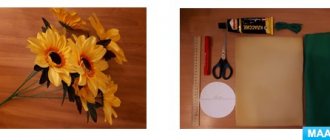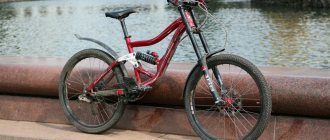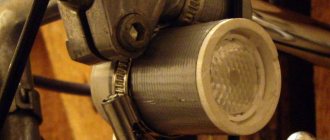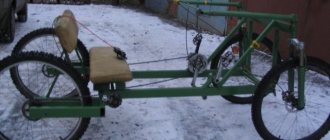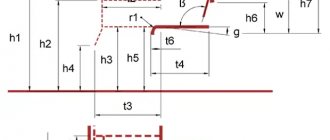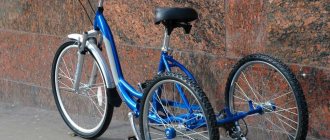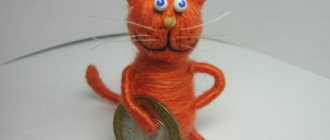How to choose a child seat
When choosing a seat for the trunk, take into account the model of your bike and the diameter of the wheels.
Rear-type seats are installed on almost all bicycles, except double-suspension ones, with wheel diameters from 26 to 28 inches. When making a purchase, look at the specified wheel diameters in the seat specifications; Check the maximum weight of the child seat, the method of fastening, the structural strength and the functioning of all parts; Please note that your baby may spend more than one hour a day in this chair, so do not forget to take care of his safety and comfort. Buy a protective helmet and wear it appropriately depending on the weather conditions; There should be a hole on the top of the backrest. It will save you from constantly hitting the back of the seat with your helmet.
We design a child seat for a bicycle ourselves
To create a seat yourself you will need the following materials:
- pipes of different diameters (this could be a frame from an old children's bicycle);
- seat;
- metal channels;
- welding machine;
- drill;
- long bolts.
Before welding pipes and cutting elements, it is advisable to draw up a drawing with exact dimensions. Using a drill, holes are made for fastenings in a row to allow height adjustment.
A seat is screwed to the top edge of the T-piece. Next, it is installed on the bike. To do this, you need to place the seat against the frame and tighten the bolts on the vertical channels from the bottom and top of the frame pipe.
A homemade bicycle seat for a child will be less safe than a professional seat. The main task of the parent will be to be attentive on the road and control the child.
When riding a bicycle with a baby, you should try to avoid potholes and bumps and sections of the road with busy traffic. It is also advisable not to travel to places where you can meet stray dogs, which often rush at a vehicle and can frighten a child. When traveling with a small passenger, you must comply with speed limits and other traffic rules.
Proven children's chairs on a frame
Let's look at some very successful options from some manufacturers.
Bellelli Tattoo handlefix
Child seat for bicycle frame or stem Bellelli Tatoo handlefix. A bicycle seat from an Italian manufacturer can support a child weighing up to 15 kg. Comfort is created due to the soft seat and ventilated backrest. Mounting is carried out both on the frame and on the handlebar stem. The diameter of the pipe, depending on the fastening, should be 21-26 mm, 25-36 mm. Adjustable straps keep your baby securely in the seat. The footrest is adjusted to the length of the legs, which are protected on three sides. The feet are secured with straps.
Bellelli Rabbit handlefix
Children's bicycle seat Bellelli Rabbit handlefix. Installation is carried out on the frame or steering tube. The seat can support a baby up to 15 kg. The chair is made of plastic, and the parts are made of steel. There is a small soft padding on the chair. The foot platform is protected on three sides, adjusts in height and secures the foot using straps. There are holes for ventilation on the back of the seat. Safety is ensured by a three-point strap.
Hamax Caress Observer
Children's bicycle seat on the Hamax Caress Observer frame. The maximum child weight for this bike seat is 15 kg. The seat is attached to the steering tube (tube diameter 22-40 mm) of the bicycle using a bracket. There is a soft insert on the back of the chair. The footrests are adjustable and have fasteners for fixation. The safety straps are adjustable and do not cause any discomfort to the child. Instead of side walls, the bike seat is equipped with handles, allowing the child to enjoy a large viewing radius.
Well-known manufacturers of bicycle seats
Hamax is a line of comfortable, practical and durable children's bicycle seats. The exceptional quality of materials and workmanship in accordance with the European standard EN 14344 will allow you to delight your child for more than one season and even leave the chair for the next baby.
The seat, depending on the model, can be mounted on a pin or trunk. To install it on the trunk, you will need a simple part - an adapter bracket. The range of seat tubes is from 28 to 40 mm in diameter. The chair is adjustable in angle, height and position of the footrests. Transportation age – from 9 months to 7 years, nominal load capacity – up to 23 kg. Three-point safety system and additional chest strap. Material: wear-resistant and non-toxic propylene.
Belleli bicycle child seats are available in both front and rear models. The chairs are made in the form of “thrones”, which children will definitely enjoy. The seats are equipped with seat belts and wide footrests. Fixation of the body and legs, which is especially important for the little ones.
The age of the transfer is from 1 to 7 years, the loading weight is up to 22 kg. The tension is adjustable; for rear-mounted seats, the backrest tilt position is adjustable. What else should be noted about Belleli bicycle seats is the variety of colors. And children, as you know, love bright and colorful things.
Article on the topic: Do-it-yourself carved solid wood furniture
Britax&Romer is a manufacturer that always puts safety and comfort first. Comfortable and adjustable seats, reliability and ease of fastening, high (up to 25 kg) load capacity, three- and five-point seat belts. The lineup pleases with a large number of budget options.
A bicycle seat from a good manufacturer is reliable, high quality, and safe. However, those who like to invent and complement are probably wondering whether it is possible to assemble it themselves.
Additional seats
The most “classic” option is to attach an additional seat to the bicycle frame. There are two ways here:
- fastening the seat to the frame;
- attaching the seat to the trunk.
Rare models of additional seats are equipped with protection. The maximum that can be found from manufacturers is belts for fastening a child.
If, in the case of self-production, an additional seat is an ordinary bicycle saddle removed from the pin, then manufacturers put a lot of effort into organizing the correct fastening, because on most modern bicycles the cables in the jackets can interfere with installation, and vice versa, after installation the cable can, for example, fray .
It's even more serious if the brake drive is hydraulic. Here the drive must be protected not only from the fasteners, but also from the small passenger, because repairs are unlikely to be included in the plans of the parent who decides to ride.
Although very rare, additional seats for the trunk are made. They are attached with very simple brackets, but placing a child fastened with only one seat belt and sitting on an open seat is not the most sensible thing for a parent who cares about the health of his child.
Types of children's bicycle seats
Child bicycle seats can be mounted on the frame at the front or rear. Both mounting options have their advantages and disadvantages. To choose the optimal model, it is worth studying in more detail both types of child seats for a bicycle frame.
Children's bicycle seat on front frame
The seat is mounted on the bike frame or steering column. Thus, the baby finds himself between the steering wheel and the bicycle driver.
Advantages of the model:
- parents have complete control over the child, can freely communicate with him while driving, monitor his actions;
- the child feels safe knowing that the parent is sitting behind him, and therefore calmly endures cycling;
- the trunk remains free and can be filled with useful things;
- the chair provides protection for the legs and body;
- the seat is equipped with seat belts;
- a child's chair on a bicycle frame has a high back, convenient for fixing the head;
- creates a shock-absorbing effect.
Flaws:
- children's bicycle seats on the front frame are small-sized seats that can withstand loads of up to 15 kilograms. As the baby grows up (after reaching 3 years), the seat will have to be replaced;
- it is difficult to select the optimal model, especially if the seat is needed for installation on a sports bike;
- creates inconvenience for the cyclist - it interferes with pedaling and reduces the quality of the road view.
Rear child seat for bicycle frame
The seat, attached to the back of the bike, is suitable for children up to 6 years old, whose weight does not exceed 25 kg. There are two options for mounting the rear seats:
- the first mounting method is on the seat tube;
- the second way is on the trunk.
Both mounting options have their strengths and weaknesses. A comparative table of the “pros” and “cons” of both options will allow you to make the best choice.
| Advantages | Flaws | |
| Trunk mount | 1. Versatility. Seats with this type of fastening are suitable for all models of bikes with a trunk. 2. Can support children weighing up to 25 kilograms. 3. Reliability. The seat is firmly fixed to the frame. 4. Driver safety. A child's seat on a frame does not block the cyclist's view. | 1. The lack of a shock-absorbing effect causes discomfort while driving off-road. 2. The parent cannot monitor the baby and control what he does during a walk |
| Seat tube mount | 1. Has excellent shock-absorbing effect. 2. Convenient to transport. 3. Universal sizes provide a comfortable position for the child. 4. Suitable for all bicycles except models that have rear shock absorption. | 1. There is no way to monitor the child. |
Security questions
In order to comply with the principles of safe driving with a child, it is necessary to take into account three important points:
- The first is a fairly strong seat mount. This is achieved by using high-quality clamps and duplicating attachment points. Simply put, there should be not one fastening, but at least two, and preferably three.
- The second is the child’s location. You need to take into account in advance how the child will sit so that he does not interfere with you driving the bike, and his legs cannot get into the wheels under any circumstances.
- The third is the seating position. If your child is under six years old, consider placing the child's bike seat only in front of the adult's seat so you can be in control at every stage. If your child is already in school and is alert enough to hold on tightly while riding, you can consider placing the child's bike seat behind the parent's seat, but still be very careful if you decide to use this installation method.
If your child is under 6 years old, the child's bicycle seat must be placed only in front of the adult's seat.
Choosing a seat for a child's bicycle seat
Well, now let's get to the fun part. At this stage, you can be creative and choose the option that will be most convenient for your child. What can you use to make a children's bicycle seat with your own hands? Here a lot depends on the age of the child.
If your child is still a toddler, you can use an old high chair with armrests, or you can assemble the seat yourself. There are craftsmen who construct such seats from scraps of plastic pipes and a piece of plastic or plank as a base. All you need is the seat itself, the backrest and armrests that will prevent your baby from falling out when turning.
If your child can already balance on his own, you can take a seat from an old bicycle and simply weld it to the frame or secure it with clamps. This is the simplest option, which is used by many who want to quickly design a children’s bicycle seat with their own hands.
You can be creative when making a child's bicycle seat
What's the benefit?
Firstly, for some unknown reason, children's bicycle seats usually cost exorbitant amounts of money. Often their cost can be compared with the price of an adult bicycle, and not the worst. And this despite the fact that the budget of a young family is often very limited, and a bicycle seat is rarely the number one need.
Secondly, by designing a bicycle seat with your own hands, you can choose the seat yourself, taking into account the needs of your child and your own comfort. Things will be easier with repairs if necessary.
Article on the topic: DIY standing desk
Choice by price
If, when choosing other accessories, a lot of attention is paid to well-known brands, many models and a choice among them, then when it comes to such unpopular devices as a child seat, the choice is too small. Stores, due to low supply, raise prices, and manufacturers, paying little attention to this area, do not particularly monitor competitors
When choosing, price is not what you should focus on. When purchasing, just check:
- Are the fastenings secure?
- Is the foundation strong?
- Is the fit and size comfortable?
The rest of most models, even those not related to well-known brands, are on the same level, and the cost rarely indicates the real quality of the product.
How to make a baby chair with your own hands
Making your own child's bicycle seat is an additional solution if you have the right material, tools and skillful hands.
Making a bicycle seat with your own hands is not an easy job. Therefore, it is necessary to consider the method of connecting the device to the bicycle and take into account the safety of the child while riding. But first you need to choose the original version of the bicycle seat. You can use an old children's chair or high chair. Drill holes in the seat, and use a metal plate, washers and nuts to attach the bike seat to the trunk. Sewing the seat to give softness and comfort to the passenger. Fasten seat belts if they are not provided on the seat. To protect the legs, use plates on the sides of the wheel or wire that is braided around the fixed rods.
The safety of your child riding on this home-made device is entirely up to you, so don’t mess around or use fragile material.
Features of a children's bicycle seat for the frame
A child seat attached to the frame has narrower limits on the weight and age of the child than a seat on the trunk. Most often used for children no older than 3 years (15 kg), since an older child will interfere with control of the bicycle and their weight will increase the risk of losing control of the bicycle.
The dimensions of the bicycle seat are smaller than the seat attached to the trunk. In addition, there are many models that differ in the method of fastening, child protection and the size of the structure.
The seat can be mounted on almost any bicycle, except for bicycles with speed shift and brake cables running along the outside of the tube. In this case, choose a seat mounted on the seat tube of the frame or on the steering column tube.
The chair is secured using a lock-holder or two fixed rigid “whiskers”.
Most often, a child's bicycle seat installed on a bicycle frame is equipped with:
- soft removable lining on the seat;
- adjustable contact belts for child safety;
- side walls to protect the child’s legs and torso;
- adjustable footrests with straps, depending on the age of the baby;
- Front handrail protection may be available.
Design options
When choosing a bicycle seat, you should make sure that it complies with EN14344, the European standard for child bicycle seats. This guarantees a sufficient level of reliability and safety. The EN14344 standard introduces three approved classes of seats:
- A15 - rear seats for children weighing up to 15 kg.
- A22 - rear seats for children weighing up to 22 kg.
- C15 - front seats (where the child is between the parent and the steering wheel) for children weighing up to 15 kg.
REAR SEATS WITH FRAME MOUNTING
To date, the design of most bicycle seats has already been brought to an optimal level, ensuring maximum comfort and safety of the child, as well as reliability of fastening.
In the most common case, the chair is installed on a bicycle using an elastic lever made of two steel pipes attached to the seat tube of the frame. Thanks to this lever, the chair sways slightly on uneven surfaces and makes the ride as comfortable as possible for the child. The weight of such a chair is on average 4-6 kg. To ensure safety, the standard seat must be equipped with 3- or 5-point seat belts, developed shields that protect the child from touching the wheel, adjustable footrests with fixing ties, head and side protection. In good models, the back of the chair or the entire chair can recline back when the child is sleeping.
The chair is attached to the frame using a massive fastening unit, which secures the suspension pipes with a quick-release clamp. The fastening unit can only be installed on a metal seat tube of the frame (usually of round cross-section), and at the installation site it should not touch the wheel or conflict with the cable stops or bottle cage bolts.
All these difficulties make it impossible to install the chair on racing bicycles, most dual-suspension bikes, 29″ bikes with a small frame (in the photo on the right - the Britax chair mount has only a few millimeters of clearance with the tire on a 29″ frame with an 18″ size) and a number of other designs, where the design of the frame, cable stops or bolts prevent the installation of fasteners. Manufacturers prohibit attaching the chair to the seatpost for safety reasons.
Article on the topic: DIY rocking chair for children
In general, this particular version of the chair is the most reliable and optimal in its characteristics, but only if compatibility with the bicycle frame is achieved.
REAR SEATS WITH TRUNK MOUNTING
Some bicycle seats can be mounted on the trunk using special clamps. Thanks to this, the problem of compatibility with the frame is removed, but a number of other problems arise. Firstly, due to the absence of an elastic lever, shaking and vibration are transmitted much more strongly to the chair, which is already comparable to shaking in a bicycle trailer. That is, driving on bad roads with such a seat will obviously be less comfortable. However, some seats have a built-in damper attached to the trunk, which somewhat improves the smoothness of the ride.
Secondly, not every trunk can withstand the installation of a chair (seat manufacturers sometimes offer special trunks for this purpose). For example, the German company Tubus, well known among bicycle tourists, directly prohibits attaching bicycle seats to its steel and titanium racks. The seat manufacturers themselves require that the trunk be designed for at least 25-30 kg - few aluminum trunks can withstand such weight. Of course, we are not talking about any console trunks here.
Moreover, if a broken trunk on a hike is just a problem (quite common), then when transporting a child on it, this can already lead to an emergency end to the trip. Thus, attaching the seat to the trunk has significant disadvantages and can only be recommended if there are no other options.
FRONT SEATS
To transport small children (up to 15 kg), lightweight front seats are available, in which the child sits in front of the parent and looks forward. This design of the seats is very good in terms of visibility and the ability to communicate with the parent, but the center of gravity is even higher than with the rear seat, and due to the rigid attachment to the bicycle, vibrations are about as high as with the previous option.
Article on the topic: DIY shoe chair
The applicability of such a mount on sports bikes, where the rider is leaning forward, is a big question, since there is a risk that the parent’s chin will knock on the child’s helmet. Also, the child is exposed to all winds, from which the parent’s torso is partially protected in the back seat - to combat this, manufacturers offer a wind shield-fairing.
It would be useful to remind you that installing the chair on the top tube of the frame puts undesigned loads on it, and in the case of an aluminum alloy frame, this can lead to rapid failure. Therefore, it is more preferable to use seats with mounting on a vertical pipe (steering tube or fork stem), however, not every bicycle supports the possibility of such installation. We can say that the compatibility problem here is the most acute of all bicycle seat options.
ACCESSORIES
Manufacturers offer a wide selection of accessories for use with bicycle seats, namely:
- Children's raincoats
- Headrest pillows
- Kits for installing on a second bike
- Small frame bike kits
- Additional or replaceable shock-absorbing cushions for the chair (for example, inflatable)
- Rain covers
- Car rack kits
- Wind deflector for front seat
- Luggage racks optimized for installation of child seats
ARTISTIC OPTIONS FOR CHAIRS
Searching for bicycle seats in Chinese stores, as well as observing how children are transported in villages, gives a lot of handicraft ways of transporting children, limited only by imagination:
- soft pillow for the trunk;
- a soft cushion or saddle on the top tube of the frame, sometimes with supports for the legs;
- various plastic chairs with handles for holding;
- a chair where the child sits backwards and looks at the parent's groin, as well as many other options.
All of these options do not have seat belts, and one can only guess what will happen to the child in the event of a fall.
Article on the topic: How to stop a puppy from chewing furniture
Pros and cons of a child seat for a bicycle on a frame
Advantages:
- the child is in the parent’s field of vision at all times;
- attaches to both the frame and the steering column;
- nothing prevents children from seeing the world around them;
- the child is delighted with the trip, as he feels like he’s in charge;
- the free trunk can be used to carry the necessary things with you.
Front seat disadvantages:
- Suitable for short bike rides, for example in the park. When covering long distances, the child may get tired;
- lower level of safety than the rear seat;
- the need for windproof clothing, since the baby is not protected from the wind in the front seat;
- some seat models may interfere with the cyclist's ability to pedal;
- A cyclist may hit his child's helmet with his chin.
Types of bicycle seats for children
For the safety of the child, a car seat is used in the car, without which it is prohibited to drive with the child, otherwise this may lead to a fine. But on a bicycle they use a bicycle seat, which ensures safety and ease of constant use.
Types of bicycle seats for children differ from each other in the place of fixation:
- Ahead;
- Behind.
We will describe each of the fastening methods below.
Front bicycle seat with frame mounting
Most parents believe that the front mount is much more convenient for both the parent and the baby. However, there is also a category of cyclists for whom the mount is not convenient due to the fact that maneuverability becomes reduced and the possibility of a child’s head colliding with an adult’s chin. Front bicycle seats are usually much smaller than others, so they have reduced safety characteristics, and this can lead to unfortunate consequences in the form of fractures and abrasions.
Article on the topic: DIY rocking chair made of metal
Important! A child seat on the front frame can be installed on any model of bicycle, including those with a rear shock absorber.
This chair is most often fixed to the front frame, but there are models with mounting to the seatpost or handlebars.
The advantages of a front mount are:
- It is much more interesting for a child to ride in front because he can look forward and to the sides;
- An adult can see what condition the baby is in;
- The trunk remains free.
But besides the advantages, it has many disadvantages that may affect the choice:
- The protection is not secure enough;
- Difficulty handling the bike;
- The maximum weight of a child for transportation is only 15 kilograms, and therefore is only suitable for a child up to 3 or maximum 4 years old.
Rear bike seat
Rear - for real cyclists, this option will be a priority; its advantages will be the absence of obstacles in control and reliable protection of the baby even if the bike falls. Some models of chairs can be reclined so that the child can fully relax.
Rear-mounted seats are designed for children weighing up to 22-25 kg. Thus, depending on the type of chair, you can take a child up to 6-7 years old with you on walks.
Seats of this type can be mounted on a seatpost or trunk.
1. Attaching to the seatpost is a fairly simple and proven method. The main advantage of this type of fastening is the amazing comfort of the child, which is ensured thanks to its shock-absorbing properties. The chair is suspended and literally swings in the air. Attaches to the seatpost and does not require additional elements. The main thing when installing is to know the diameter of the seatpost and its shape.
After installing the lock on the seat post, the seat can be removed/installed with one click; if the family has another bicycle, you can purchase and put a lock on it, so you can carry your child one at a time, easily moving the seat from one bike to another.
Article on the topic: DIY rocking chair made of wood
The positive points include:
- Easy to mount;
- Good shock absorption;
- You can put a bag of groceries on the trunk without disturbing your child.
And the disadvantages are:
- Inability to look at the child;
- Small viewing angle.
2. Child seat for bicycle on trunk. Chairs of this type are installed on the trunk of a bicycle and are securely fixed to it. One of the simplest and most universal methods, which has long proven its reliability. The main disadvantage is the complete lack of shock absorption, which leads to discomfort, and the child will feel it more strongly than the parent. It follows that this method of fastening is suitable for smooth roads in park areas.
Some design features
The front frame bicycle seat is made of impact-resistant certified materials; the base is a durable plastic frame. The accessory is attached to the steering tube or front triangle pipes.
Most models of children's bicycle seats with a front frame are suitable for children weighing up to 15 kg. A child's bicycle seat must be equipped with seat belts and adjustable leg supports. The harnesses come in three- and five-point versions, please note that they can be adjusted as the child grows.
Note: It is best to purchase a bicycle seat “in person”. This way you can make sure that the accessory fits the bike and your child feels comfortable in it.
Note
When purchasing, evaluate the quality of the materials and check for a certificate. The bicycle seat must be equipped with a foam or fabric insert so that the baby does not slip on the plastic of the seat. The footrests should be adjustable; it is better to choose an option with enhanced leg protection.
The baby's weight is another selection criterion. Do not buy an accessory “for growth”; your child will feel uncomfortable wearing it. In addition, he will fidget and make it difficult to control the bike. Models with a front bumper are very convenient, but they weigh more. Equally important is the way the chair is attached to the frame. If you do not plan to travel with it constantly, then it should be easy to remove and put back.
Article on the topic: DIY pedicure furniture
Results
Placing a child seat on a bicycle frame has its positive and negative sides. The negative side of a child seat on a frame is the inconvenience of driving a bicycle, but this problem can be solved with a smaller seat. But keep in mind that even with a small bike seat you shouldn’t ride on long, much less uneven routes. This is an ideal option for slow walks on asphalt surfaces with a child weighing no more than 15 kg. If the desire to ride with your baby is stronger, regardless of the negative aspects you have read, namely the controls and the danger of falling, then it’s worth a try. But it completely depends on your riding skills. A pleasant trip will bring so much pleasure to the cyclist and the child in the children's bike seat that it will be remembered for a long time.
The importance of transporting children safely
However, the trip should not only be useful for both passengers, but also safe. It will be safe only if the bicycle seat meets the following criteria:
- Protection. It should be not only in the leg area, but also on the sides. If it is present, sudden braking is the safest for the child.
- Fixation. It involves the use of seat belts and a certain fixation of the legs, which prevents the legs from getting caught in the spokes or being injured when falling.
- Indication of age and weight restrictions. Most manufacturers indicate that children can be carried from the age of 9 months. Weight limit: no more than 22 kg. But pediatricians say that it is prohibited to carry children with a weak spine on a bicycle. And the backrest of the bike seats is not adjustable, and children get tired quickly from long bike rides. Therefore, you should not rely on general recommendations.
- Head rest. Some babies may fall asleep during the trip. To prevent sudden movements of the head beyond the seat on bumps or during braking, the presence of a head rest is necessary.
- Possibility to transport women. In order for a mother and child to cycle safely, bicycle seats must be optimized in shape for comfort and visibility. Many brands have already foreseen this for a long time.
- Depreciation. Its absence can be traumatic for a young child. But the presence of a pair of springs makes the ride softer.
- The seat should not interfere with steering wheel turns.
